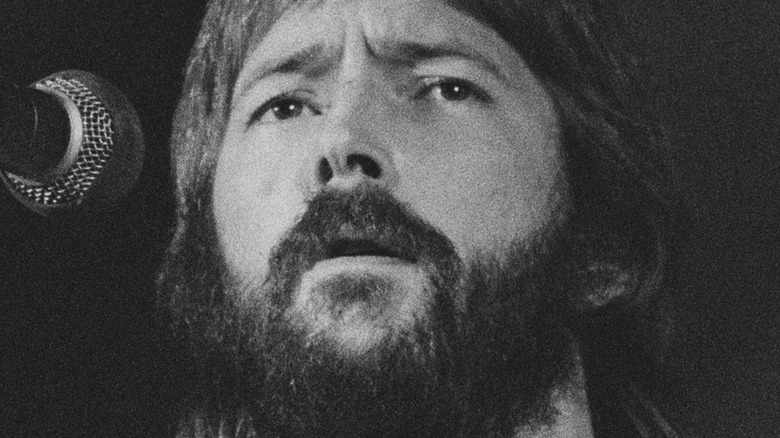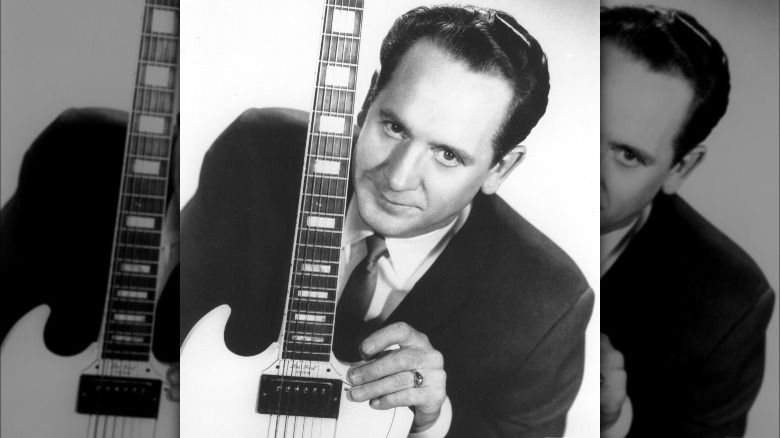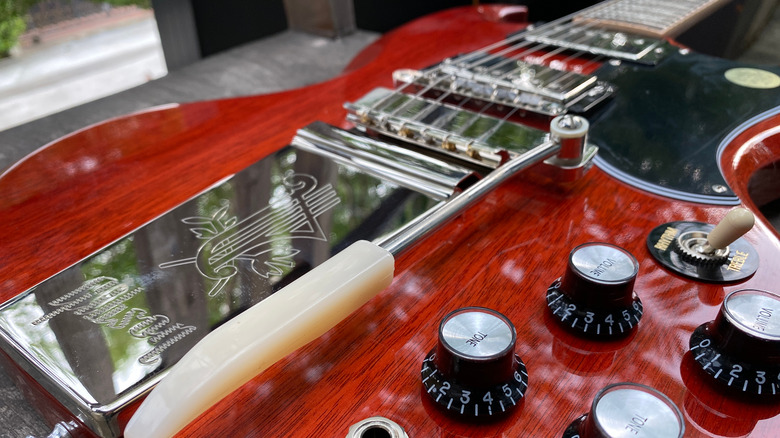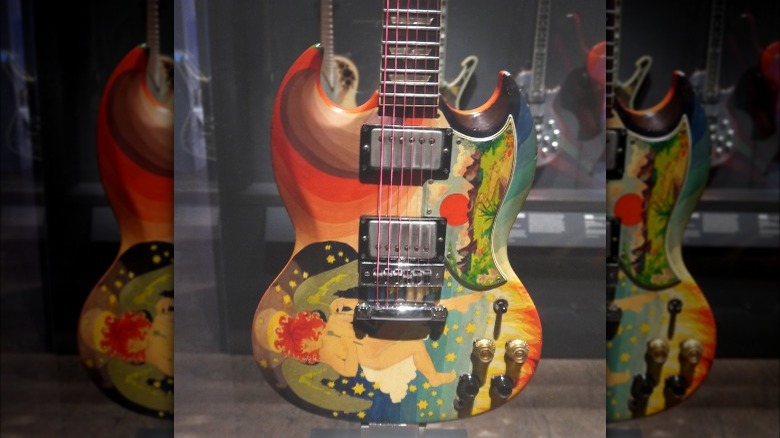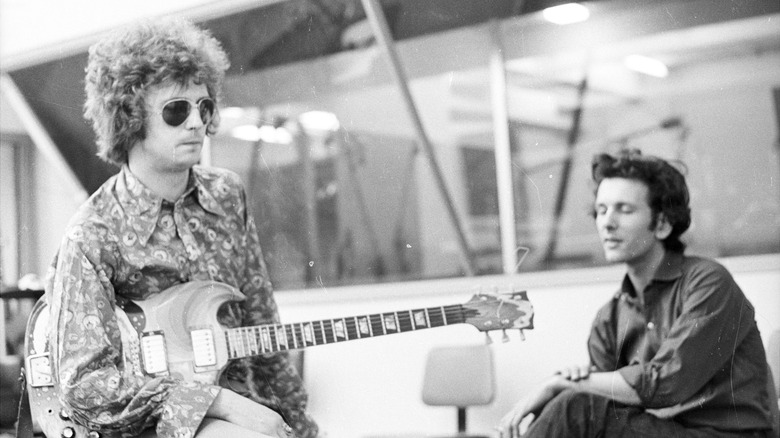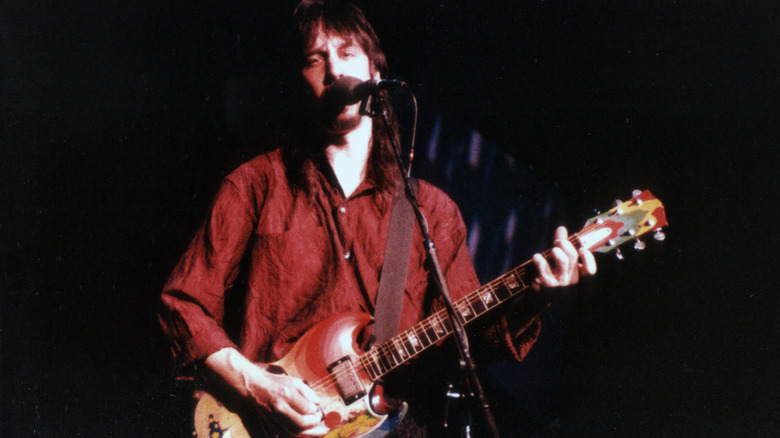Eric Clapton's Famed Guitar Had A Long Journey Through Rock Music
There are a handful of guitars in rock 'n' roll history that have gone on to attain their own level of notoriety. For instance, Peter Green's 1959 Gibson Les Paul at one point belonged to blues legend Gary Moore and is now owned by Metallica ax-man Kirk Hammett. That guitar's unique sound and the stories that surround it — it has been reportedly played by everyone from Jeff Beck to Jimi Hendrix to Rory Gallagher to George Harrison, per Music Radar — has garnered the guitar it's very own fans. Elsewhere, Eddie Van Halen's iconic red, white, and black-striped Frankenstrat — a DIY project of sorts where the legendary shredder tried to combine a Fender Stratocaster and a Gibson Les Paul — wound up inspiring a completely new kind of high-performance guitars known as Super Strats, per Reverb.
Another famous guitar that is known for its tone, as well as its striking, psychedelic paint job, is Eric Clapton's Gibson SG, dubbed "The Fool." The instrument changed hands several times over the years and was owned by several members of rock royalty.
The story behind the Gibson SG
One of the names most synonymous with the electric guitar is Les Paul. According to Britannica, Paul was an extremely talented guitarist and wrote several hit songs alongside his wife, Mary Ford. However, Paul didn't just play the guitar — he was also obsessed with bending his instruments to meet his musical needs. Earlier in Paul's career, the only guitars on the market were hollow-body guitars, and the main problem facing that style of guitar is that they're susceptible to feedback when played at loud volumes. Paul — along with other contemporaries, including Leo Fender — experimented with solid-body guitars that solved this problem.
Gibson began producing a model called the Gibson Les Paul that featured a solid body, and while it's an icon today, it wasn't a huge success for the company, so they discontinued the original design. In 1961, a new model with a thin body and a pair of sharp horns was introduced and called a Les Paul (via Guitar World). This was the Gibson SG as it's known today, and its namesake wasn't a fan of it. According to an interview his former guitar tech, Tom Doyle, did with Guitar World in 2021, Paul wasn't a fan of the new design's thinner neck and its lack of sustain compared to the previous model. His contract with Gibson expired a few years later, and the model was renamed the Gibson SG; the "SG" is short for "Solid Guitar" (via Guitar World).
Clapton buys an SG
In the 1960s, Eric Clapton was one of the hottest guitar players in the world. So hot, in fact, that the words "Clapton is God" were even painted on a wall at the Islington Tube station in 1967, per GQ. That same year, Clapton was playing with his three-piece band Cream and was in the market for a new guitar. According to Reverb, Clapton was in a music store on a rare day off, taking a look at guitars. Earlier on Cream's tour, he previously owned a pair of Gibson Les Pauls — the original, single-cutaway style — before they were stolen, and for whatever reason, he decided to try something new and bought a 1964 Gibson SG standard with a cherry red. Other sources — like Vintage Guitar — claim that the guitar was given to him by George Harrison.
The SG offered Clapton a lot of the features he was familiar with from his Les Pauls. The volume and tone knobs were in a similar layout, and both guitars featured a pair of humbucking pickups (though their pickup selector switches were in different locations). But one advantage the SG had was that its double-cutaway design allowed Clapton easier access to some of the higher frets than he could on a Les Paul. It's believed that Clapton first brought the guitar to Cream rehearsal on March 15, 1967 (via Reverb). This is because demos recorded that day seem to feature the SG's Deluxe Vibrola tremolo system. However, the guitar still wasn't different enough — it needed something to give it some flair.
The Fool paints The Fool
Eric Clapton knew a pair of Dutch pop-artists living and working in London named Marijke Koger and Simon Posthuma. Together they made up an art collective known as "The Fool." Clapton brought his '64 Gibson SG to the two artists, and they proceeded to paint what Calton later called in his autobiography a "psychedelic fantasy," which earned the guitar its nickname, The Fool, after the two people who painted it. The artwork covered every inch of the body and headstock, as well as the back of the neck. According to Reverb, Koger and Posthuma also did some work for Eric Clapton's Cream bandmates. They did some bass drum heads for drummer Ginger Baker and gave bass player Jack Bruce's Fender Bass VI. However, Bruce didn't like the way the paint felt on the guitar, so he started playing a Gibson EB-3 — a bass shaped like an SG — instead.
Later the same year, The Fool would make music history again, this time painting a massive psychedelic mural on the exterior of the Beatles' Apple boutique. The mural wasn't well-received by nearby business owners, and the local city council made the Beatles do away with it.
Modifications, the woman tone, and changing tastes
Eric Clapton continued to modify the guitar in ways other than just its eye-catching paint job. One of the early modifications was when he removed part of the guitar's Deluxe Vibrola system — the long metal tail-piece cover that stretches from the bridge to the end of the guitar. According to Reverb, it's thought that this had less to do with the guitar's performance and more to do with wanting to show off more of The Fool's psychedelic artwork. Clapton went on to disengage the Deluxe Vibrola and eventually had it fully removed.
Clapton seemed to like the guitar, and in the late '60s, it became his main instrument both on stage and in the studio. In a 1968 interview with English director Tony Palmer, Clapton discussed one reason of the big reasons for his affinity toward The Fool — it helped him achieve what he called the "woman tone," which was achieved by either using the neck pickup or by using the bridge pickup and rolling the tone control all the way down. However, The Fool wasn't the only guitar he used at the time, as according to GroundGuitar, Clapton also used a Fender Telecaster in the late 1960s, and he toyed with other Gibsons like a Firebird I and an ES-335. Eventually, Clapton became known for favoring Fender Stratocasters, and as such, it was time for The Fool to find a new home.
The Fool's famous owners
According to Reverb, it's believed that the first person to acquire The Fool after Eric Clapton was none other than George Harrison. Some have thought that Clapton simply left the guitar at Harrison's house, per Vintage Guitar. This has never been truly verified, and the only proof that Harrison owned the guitar is circumstantial, as the next verified owner of The Fool was Jackie Lomax, a musician who was a friend of Harrison's from Liverpool.
In the early 1970s, The Fool found yet another new owner, and this time it was musician and producer Todd Rundgren. In an interview with Guitar World, Rundgrend indicated that he had heard Harrison once owned it and added that he also heard it was once owned by Paul Kossoff, guitarist for the band Free. Rundgren said that when he got the guitar, the famous paint job was in bad shape because Marijke Koger and Simon Posthuma didn't apply any kind of sealer to protect their artwork.
Rundgren said that he fixed it up and owned it until the 1990s, even playing the Cream classic "Sunshine of Your Love" with Jack Bruce and Beales drummer Ringo Starr. The guitar is currently on loan to The Metropolitan Museum of Art, which is fitting given the iconic art that covers the entire instrument, though it is not currently on display.
